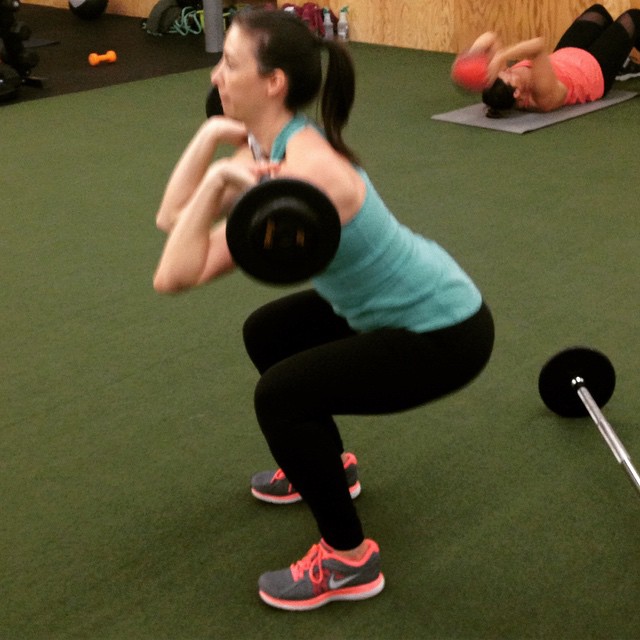You may have noticed that every workout conducted at The Fitness Lab includes at least one type of squat, sometimes more. This isn’t a coincidence; squats are one of the most important exercises you can do. Why are they so important? Well, I’m going to breakdown 5 ways squats help you on your road to better health and fitness.
- Squats are a compound exercise. This means that they make you use multiple joints and muscles to complete the movement. If you visualize the squatting motion you will notice that you are bending at the hips, knees and ankles, and the main muscles worked include the quads, hamstrings, and glutes. Think of all the single-joint exercises you would have to do in order to activate those same areas. Compound exercises are also great because they improve the neuromuscular communication between the different muscle groups. Each muscle group has to ‘learn’ how to cooperate and work together, which will help with strength gains and improved coordination.
- Squats are a functional movement. Functional movements are ones that translate into everyday life and activities of daily living. Think of all the times throughout the day that you have to get in or out of a chair, bend down to pick something up, or get into an athletic stance for sport. All of these motions, and many more, mimic the squat and will benefit from completing the exercise regularly.
- Squats are versatile. You can do bodyweight squats almost anywhere. A squat in its most basic form requires no equipment and you only need a couple of feet of space. And, there are several different varieties of squat that can help keep a workout fresh. Three of the most popular styles of squat will be described below, but there are plenty of others (single leg pistol squats, front squats, split squats, etc).
- Squats improve bone health. Osteopenia and osteoporosis are characterized by low bone mineral density and bone loss. These are significant concerns as individuals age, particularly in women. One common recommendation to prevent these conditions is weight-bearing exercise. Squats, both with and without added weight, put pressure on the long bones of your legs and on your vertebrae. This helps stimulate your body to add or maintain bone density, which can help prevent fractures later on in life.
- Squats improve your balance, core, and stabilization. Although the prime movers used when squatting are the quads, hamstrings and glutes, they aren’t the only muscles activated. Because your whole body is in motion, squats also force your core and other stabilizing muscles to work hard. All of these smaller muscles work together to keep you in your correct posture, improve your balance, and help to prevent injuries.
Three squat exercises you will often see at The Fitness Lab are the double leg squat, the squat jump, and the goblet squat. They are each explained below, but remember that before trying any of these in a workout it is important to have a proper warm-up. In fact, the double leg bodyweight squat is often used during the dynamic warm-up before classes and personal training sessions.
- Double Let Squat – Standing with your feet, hips width apart and toes pointing forwards, drop your hips back as if sitting in a chair. Keeping the weight on your heels and your back flat drive up into a standing position. Aim to get your knees to approximately 90 degrees and keep your knees from going forward past your toes.
- Squat Jump – Using the same positioning as the double leg squat, jump up for maximal height. Have your arms at your sides and use them to help you gain momentum and drive yourself upwards. Be sure to keep your knees from going past your toes and focus on landing softly from toe to heel. This adds in a power component to the exercise. Power is important for speed and more explosive movements. Power is also one of the first adaptations to be lost with deconditioning.
- Goblet Squat (with kettlebell) – This is one way to add weight to the normal squat exercise. While holding the weight at chest level close to the body, go through the pre-described squat movement. This exercise is a little different, not only because of the added resistance, but because by holding a weight in the front of your body you activate the quad muscles much more.

